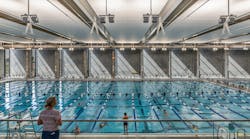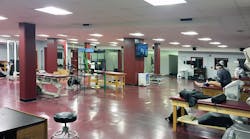The teaching tools utilized in a modern classroom are rapidly evolving. Wall-based pencil sharpeners and blackboards have left the building, while laptops, computers and Smart Boards are indispensable. Smart lighting systems, in tandem with the Internet of Things (IoT), might soon reinvent the learning experience yet again.
Better lighting controls empower instructors to manipulate the environment to maximize performance, influence behavior—for the better—improve emotional responses and achieve superior learning outcomes, says Mike Lunn, product marketing manager at Halo Recessed, Cooper Lighting Solutions and a 26-year veteran in the lighting industry. Architects should take full advantage of their entire arsenal.
“Classrooms now have to be looked at almost like office spaces where it is a computerized environment,” says Lunn. Utilizing indirect lighting is an obvious must, as is compensating for the inevitable glare that comes with having Chromebooks on each desk. But don’t forget about white tuning, Lunn cautions, which frequently gets engineered out or lost in the shuffle before construction. Color temperature can affect alertness, behavior, emotion, and attitude. If early-bird students are arriving a bit groggy, a softer color might be beneficial. Test taking might be optimal at one color, while the “after lunch, turkey sandwich blues” might require something else.
Properly lit spaces can help kids learn, but when the lighting is equipped with sensors and plugged into the Internet of Things, that’s when Lunn’s imagination begins to glow.
“It’s the art of the possible,” explains Lunn. Schools that replace fluorescents with LEDs will realize significant energy savings, meaning their new system will have a faster ROI. “So, you’re going to get this lighting control system (paid for) in X years. But if that same product—the one that you’re going to get that’s paid for in three years, five years, or whatever the ROI is—if it can also provide all this other stuff, is that of value?”
Is it valuable to know where your students and teachers are in the school? “If there’s a fire drill, your facility manager, vice principal or whoever has to go room by room to make sure that the school is empty. The teachers have to do a headcount out in the lawn to make sure everyone’s accounted for. But what if you had an app that allowed you to say, ‘In the parking lot, I see all my student badges,’ because all students have a badge when they check in anyway, as a lot of schools are moving to that kind of badge technology for attendance. If we make that an RFID tag that the lights read, now, ‘I see all the students in the parking lot, and I don’t see any badges in the school. We’re good.’”
Streamlining fire drills is one thing, but the application becomes more critical in actual emergencies. Gunshot detection devices not only count the number of shots fired, but they recognize the caliber and discern which angle the bullets came from, Lunn explains. “You can say, ‘There are three people down this hallway,’ and that is valuable information to feed the first responders and for determining how to evacuate.”
The potential for schools to easily conduct contact tracing also exists when sensors are combined with the badge system.
“If student X came in contact for 10 minutes with student Y, and nowhere did that friend group ever touch these other classrooms. I can see that,” says Lunn. “I have the data. So rather than shutting down the whole school, I can say, ‘OK, this group has to take two weeks off, but because the classroom was isolated for whatever reason during that day, we’ll only send them home while keeping everybody else functioning. What a difference that would have made for students over the last two years—and their parents.”
Teenagers with mischievous minds might not adore all these newfangled IoT-related apparatuses, such as the delinquent detectors that catch kids sneaking out the backdoor. “It can seem a bit big brotherish,” explains Lunn. “But if you’re in the school business, it’s about safety.” Ditto for the sensors that detect THC, vape and cigarette smoke. “Tie those to the badge readers,” he laughs, “now you’ll know who was smoking in the boys room.”
This article appeared in the May 2022 issue of Architectural SSL magazine.







